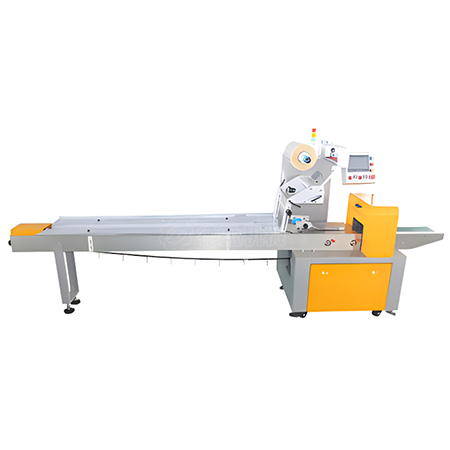A Pillow Vacuum Packing Machine, also known as a vacuum pillow packing machine, is a specialized packaging equipment used in various industries, including food, electronics, textiles, and pharmaceuticals. This machine is designed to remove air from packages or pouches and seal them tightly, creating a vacuum-packed, airtight environment for products.
Here's a detailed description of the Pillow Vacuum Packing Machine:
With three servo systems, the bag length can be set and cut without any need to adjust the idling, and it can be completed in one step, saving time and film.
Human-machine interface, convenient and quick parameter setting.
Fault self-diagnosis function, fault display is clear at a glance.
High-sensitivity photoelectric eye color mark tracking, digital input of sealing and cutting position, making the sealing and cutting position more accurate.
The temperature is independently controlled by PID, which is better suitable for various packaging materials.
Positioning stop function, no knife sticking, no waste of film.
The transmission system is simple, the work is more reliable, and the maintenance is more convenient.
All controls are realized by software, which facilitates function adjustments and technology upgrades and never lags behind.
In summary, a Pillow Vacuum Packing Machine is a versatile and essential packaging solution that ensures product freshness, prolongs shelf life, and maintains product quality by creating a vacuum-packed, airtight seal around various items. Its applications span across diverse industries, contributing significantly to efficient and hygienic packaging processes.

Q&A
What Types of Products Can Be Vacuum Packed Using This Machine?
Pillow Vacuum Packing Machines are versatile and can be used to package a wide range of products, including fresh and processed foods, electronic components, medical devices, textiles, and industrial parts. They are particularly popular in the food industry for packaging meat, seafood, vegetables, and perishable goods.
Using a Pillow Vacuum Packing Machine offers several advantages, including prolonged shelf life, reduced food waste, enhanced product freshness, efficient space utilization, prevention of freezer burn, improved hygiene, and enhanced product presentation. These machines also contribute to cost savings by minimizing product spoilage.
Vacuum packaging removes the air surrounding the product, reducing the oxidation process and inhibiting the growth of aerobic bacteria and molds. By minimizing exposure to air, vacuum-packed products experience slower deterioration, leading to an extended shelf life compared to products packaged in traditional methods.
Yes, Pillow Vacuum Packing Machines are versatile enough to handle both solid and liquid products. They can effectively vacuum pack solid items like meat cuts, cheese, and electronic components, as well as liquid or moisture-rich products such as soups, sauces, and marinated foods, preventing leakage and ensuring a secure seal.
Vacuum packing is essential in food preservation as it removes air, which contains oxygen. Oxygen promotes the growth of bacteria and spoilage organisms. By eliminating oxygen, vacuum packing significantly slows down the deterioration process, preserving the quality, taste, and nutritional value of the food for a longer period.
Vacuum-packed products are more compact and take up less space compared to traditionally packaged items. This space efficiency makes storage and transportation more streamlined and cost-effective. It also enables businesses to optimize warehouse space and reduce transportation costs, enhancing overall operational efficiency.
Several industries rely heavily on Pillow Vacuum Packing Machines, including the food and beverage industry, electronics manufacturing, pharmaceuticals, aerospace, and hospitality. In the food industry, these machines are indispensable for preserving the freshness of perishable items, while in electronics, they protect sensitive components from moisture and contaminants.
Vacuum packaging enhances food safety by creating a sealed environment that prevents the intrusion of contaminants. It protects food from bacteria, molds, and external pollutants, ensuring that the product reaches consumers in a safe and hygienic condition. This method also reduces the need for preservatives and additives, promoting natural food safety.
Yes, there are various vacuum packaging techniques, including external vacuum machines, chamber vacuum machines, and gas flushing machines. Each technique caters to specific industry needs. External vacuum machines are suitable for smaller-scale operations, while chamber vacuum machines are versatile and handle a wide range of products. Gas flushing machines introduce inert gases into the package, extending the product's shelf life.
Pillow Vacuum Packing contributes to sustainable practices by reducing food waste. By extending the shelf life of products, it minimizes the need for premature disposal, resulting in less food waste in landfills. Additionally, vacuum packaging aids in portion control, allowing consumers to store and use products more efficiently, reducing overall consumption and waste.
| Technical Parameters | |
| Packaging film width | 80/420mm |
Bag making width | 30/200mm |
| Bag making length | 150/680mm |
| Product height | within 90mm |
| Packaging speed | 60-120 packages (per minute) |
| Power supply specifications | 2.8 kilowatts, 220V |
| Machine size | 3800×800×1500mm |
| Machine mass: | 450kg |
| Servo motor | Weikong 750W |
| PLC | maintenance control |
Touch screen | Weikong |
| Switching power supply | MEAN WELL |
| Solid state relay | Yangming |